2019 VOLKSWAGEN TRANSPORTER roof
[x] Cancel search: roofPage 46 of 486
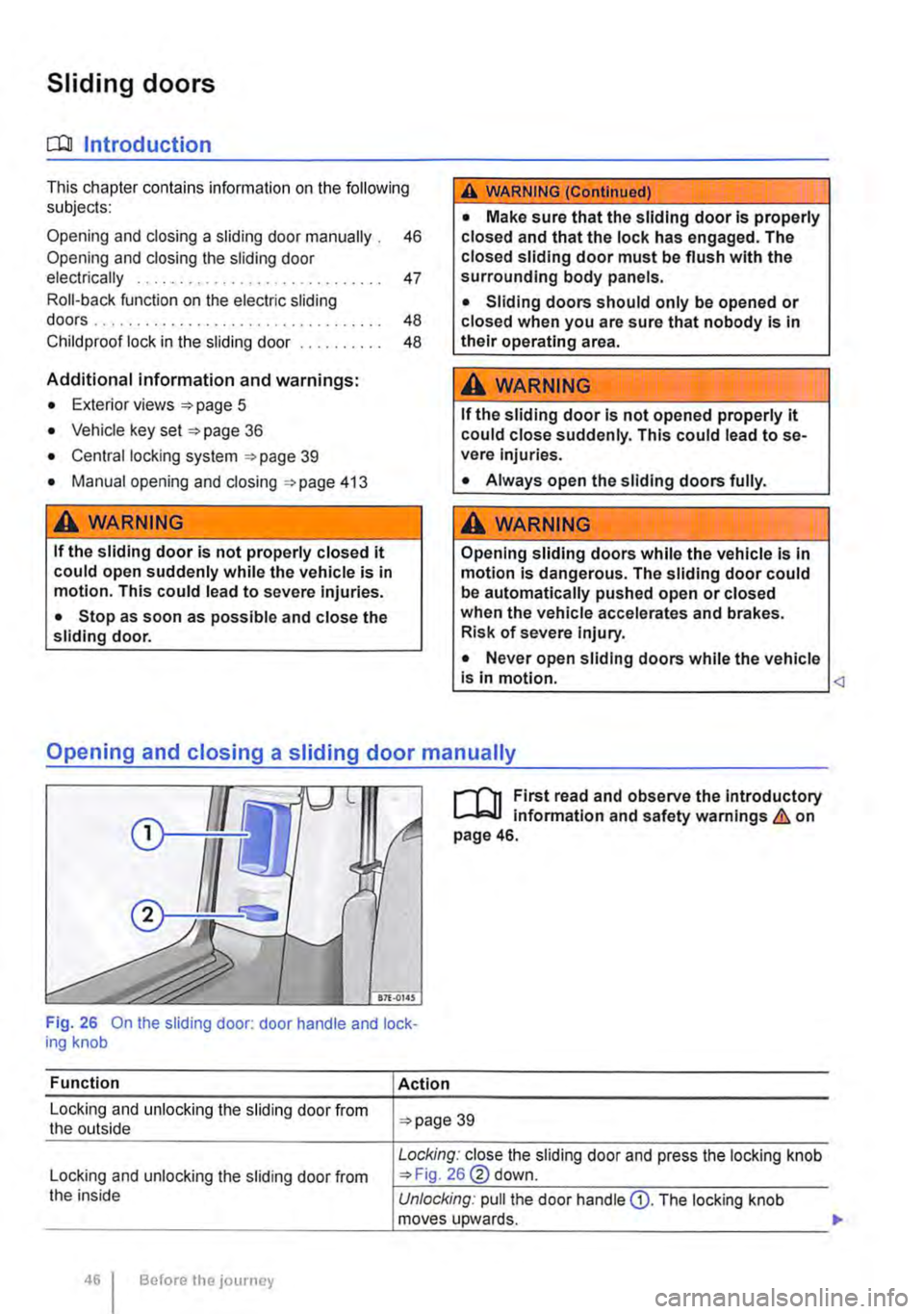
Sliding doors
o:D Introduction
This chapter contains information on the following subjects:
Opening and closing a sliding door manually . 46 Opening and closing the sliding door electrically . . . . . . . . . . . . . . . . . . . . . . . . . . . 4 7 Roll-back function on the electric sliding doors . . . . . . . . . . . . . . . . . . . . . . . . . . . . . . . . . . 48 Child proof lock in the sliding door . . . . . . . . . 48
Additional information and warnings:
• Exterior views 5
• Vehicle key set 36
• Central locking system 39
• Manual opening and dosing 413
A WARNING
If the sliding door is not properly closed it could open suddenly while the vehicle is in motion. This could lead to severe injuries.
• Stop as soon as possible and close the sliding door.
A WARNING (Continued)
• Make sure that the sliding door Is properly closed and that the lock has engaged. The closed sliding door must be flush with the surrounding body panels.
• Sliding doors should only be opened or closed when you are sure that nobody Is in their operating area.
A WARNING
If the sliding door is not opened properly it could close suddenly. This could lead to se-vere injuries.
• Always open the sliding doors fully.
A WARNING
Opening sliding doors while the vehicle is In motion is dangerous. The sliding door could be automatically pushed open or closed when the vehicle accelerates and brakes. Risk of severe injury.
• Never open sliding doors while the vehicle is in motion.
l'"'""("n First read and observe the Introductory L-J,...U Information and safety warnings & on page 46.
Fig. 26 On the sliding door: door handle and lock-ing knob
Function
Locking and unlocking the sliding door from the outside
Locking and unlocking the sliding door from the inside
Before the journey
Action
39
Locking: close the sliding door and press the locking knob 26@ down.
Unlocking: pull the door handle Q). The locking knob moves upwards. .,.
Page 48 of 486
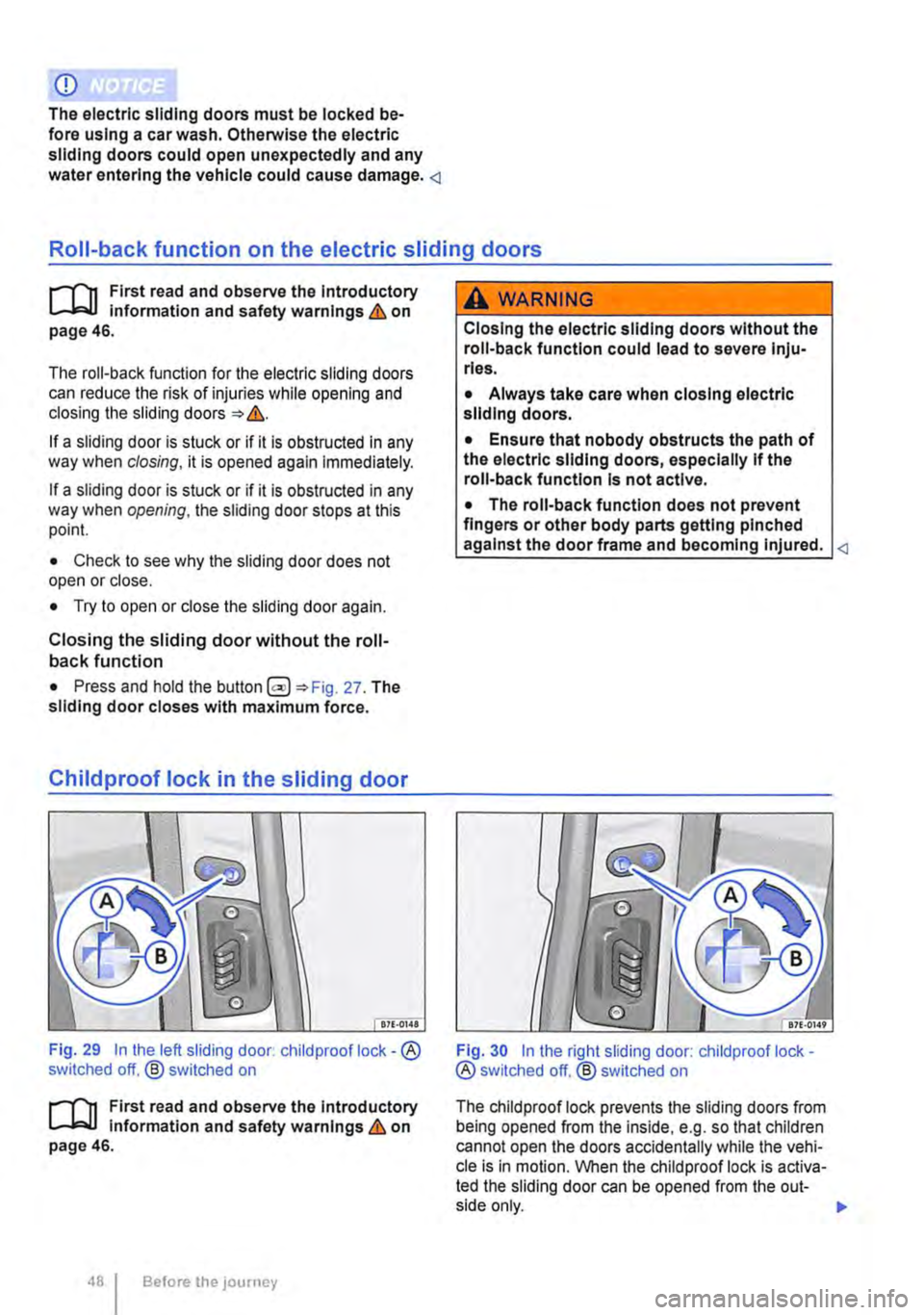
CD
The electric sliding doors must be locked be-fore using a car wash. Otherwise the electric sliding doors could open unexpectedly and any water entering the vehicle could cause damage. <1
Roll-back function on the electric sliding doors
r-T'n First read and observe the Introductory L-J,:.JJ information and safety warnings & on page 46.
The roll-back function for the electric sliding doors can reduce the risk of injuries while opening and closing the sliding doors &.
If a sliding door is stuck or if it Is obstructed in any way when closing, it is opened again Immediately.
If a sliding door is stuck or if it is obstructed in any way when opening, the sliding door stops at this point.
• Check to see why the sliding door does not open or close.
• Try to open or close the sliding door again.
Closing the sliding door without the roll-back function
• Press and hold the button§) 27. The sliding door closes with maximum force.
Childproof lock in the sliding door
Fig. 29 In the left sliding door: child proof lock-@ switched off. @ switched on
r-T'n First read and observe the introductory L-J,:.JJ information and safety warnings & on page 46.
48 Before the journey
A WARNING
Closing the electric sliding doors without the roll-back function could lead to severe Inju-ries.
• Always take care when closing electric sliding doors.
• Ensure that nobody obstructs the path of the electric sliding doors, especially If the roll-back function Is not active.
• The roll-back function does not prevent fingers or other body parts getting pinched against the door frame and becoming Injured.
Fig. 30 In the right sliding door: childproof lock -® switched off. @switched on
The child proof lock prevents the sliding doors from being opened from the inside, e.g. so that children cannot open the doors accidentally while the vehi-cle is in motion. When the child proof lock is activa-ted the sliding door can be opened from the out-
Page 49 of 486
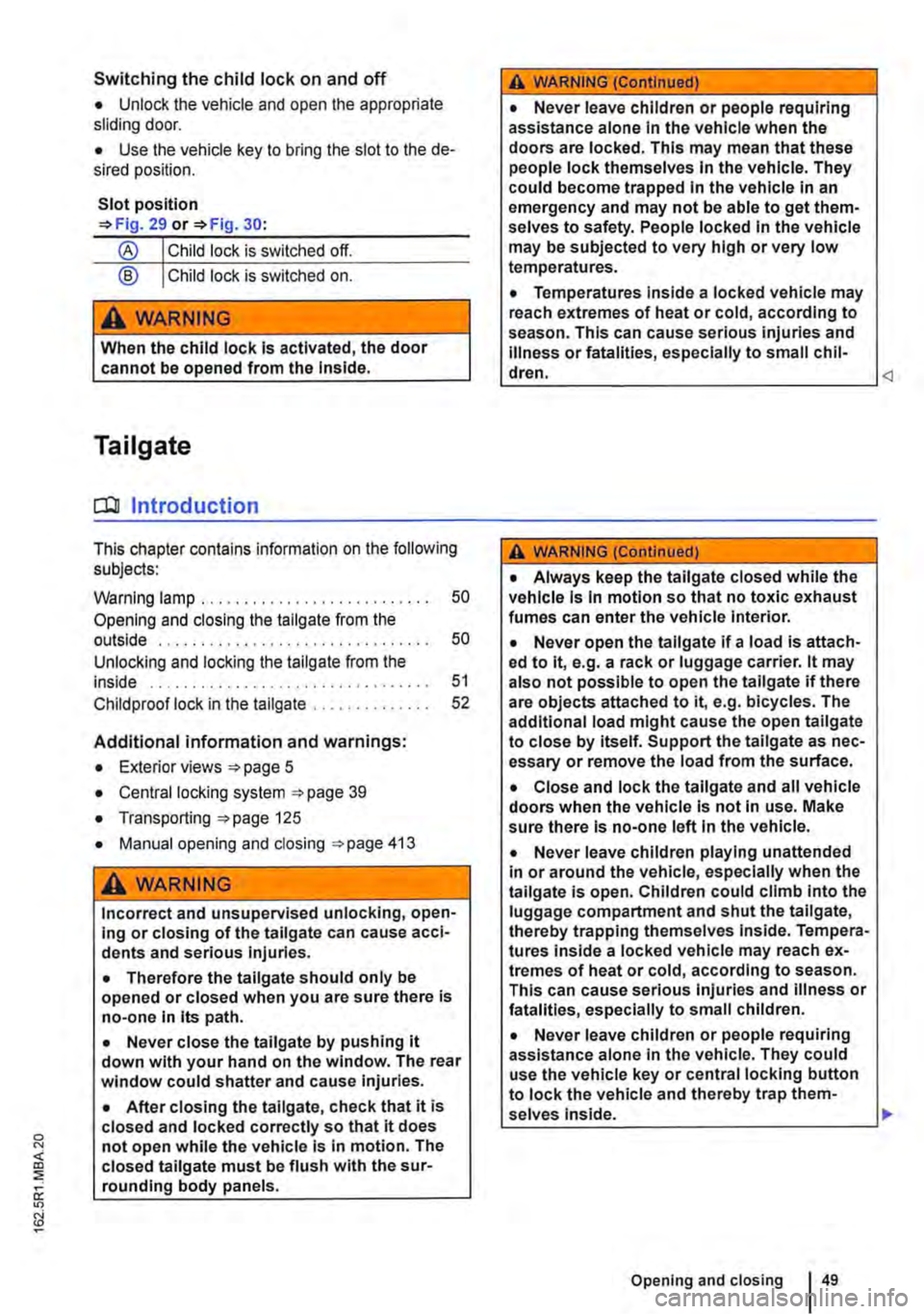
Switching the child lock on and off
• Unlock the vehicle and open the appropriate sliding door.
• Use the vehicle key to bring the slot to the de-sired position.
Slot position =>Fig. 29 or =>Fig. 30:
® Child lock is switched off.
@ Child lock is switched on.
A WARNING
When the child lock is activated, the door cannot be opened from the Inside.
Tailgate
a:n Introduction
This chapter contains information on the following subjects:
Warning lamp . . . . . . . . . . . . . . . . . . . . . . 50
Opening and closing the tallgate from the outside . . . . . . . . . . . . . . . . . . . . . . . . . . . . 50
Unlocking and locking the tailgate from the inside . . . . . . . . . . . . . . . . . . . . . . . . . . . . . . . . . 51
Child proof lock in the tailgate . . . . . . . 52
Additional information and warnings:
• Exterior views 5
• Central locking system 39
• Transporting 125
• Manual opening and closing 413
A WARNING
Incorrect and unsupervised unlocking, open-ing or closing of the tail gate can cause acci-dents and serious injuries.
• Therefore the tailgate should only be opened or closed when you are sure there is no-one in its path.
• Never close the tailgate by pushing it down with your hand on the window. The rear window could shatter and cause Injuries.
• After closing the tailgate, check that it is closed and locked correctly so that it does not open while the vehicle is in motion. The closed tailgate must be flush with the sur-rounding body panels.
A WARNING (Continued)
• Never leave children or people requiring assistance alone In the vehicle when the doors are locked. This may mean that these people lock themselves In the vehicle. They could become trapped In the vehicle in an emergency and may not be able to get them-selves to safety. People locked In the vehicle may be subjected to very high or very low temperatures.
• Temperatures inside a locked vehicle may reach extremes of heat or cold, according to season. This can cause serious injuries and Illness or fatalities, especially to small chil-dren.
• Always keep the tailgate closed while the vehicle Is In motion so that no toxic exhaust fumes can enter the vehicle Interior.
• Never open the tailgate if a load is attach-ed to it, e.g. a rack or luggage carrier. lt may also not possible to open the tailgate if there are objects attached to it, e.g. bicycles. The additional load might cause the open tailgate to close by itself. Support the tail gate as nec-essary or remove the load from the surface.
• Close and lock the tailgate and all vehicle doors when the vehicle Is not In use. Make sure there Is no-one left In the vehicle.
• Never leave children playing unattended In or around the vehicle, especially when the tailgate is open. Children could climb Into the luggage compartment and shut the tailgate, thereby trapping themselves Inside. Tempera-tures Inside a locked vehicle may reach ex-tremes of heat or cold, according to season. This can cause serious Injuries and Illness or fatalities, especially to small children.
• Never leave children or people requiring assistance alone in the vehicle. They could use the vehicle key or central locking button to lock the vehicle and thereby trap them-selves Inside. .,.
Opening and closing
Page 51 of 486
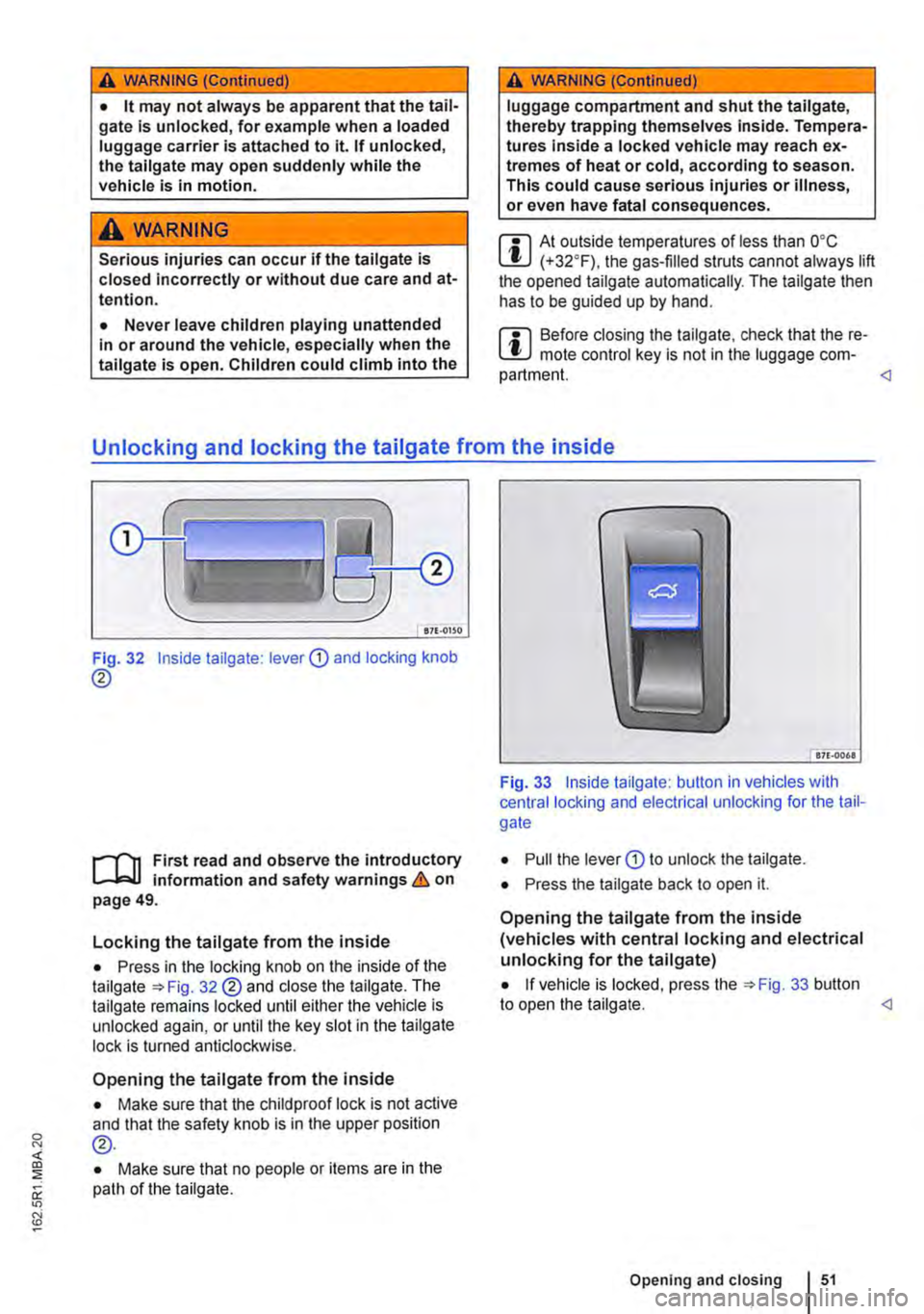
A WARNING (Continued)
• lt may not always be apparent that the tail-gate is unlocked, for example when a loaded luggage carrier is attached to it. If unlocked, the tallgate may open suddenly while the vehicle is in motion.
A WARNING
Serious injuries can occur if the tailgate is closed incorrectly or without due care and at-tention.
• Never leave children playing unattended In or around the vehicle, especially when the tailgate is open. Children could climb into the
A WARNING (Continued)
luggage compartment and shut the tailgate, thereby trapping themselves inside. Tempera-tures Inside a locked vehicle may reach ex-tremes of heat or cold, according to season. This could cause serious injuries or illness, or even have fatal consequences.
m At outside temperatures of less than O'C L!J (+32'F), the gas-filled struts cannot always lift the opened tailgate automatically. The tailgate then has to be guided up by hand.
m Before closing the taiigate, check that the re-L!J mote control key is not in the luggage com-partment.
Fig. 32 inside taiigate: lever CD and locking knob
®
1"'111 First read and observe the introductory L-W! information and safety warnings & on page 49.
Locking the tailgate from the inside
• Press in the locking knob on the inside of the taiigate =>Fig. 32@ and close the tailgate. The tailgate remains locked until either the vehicle is unlocked again, or until the key slot in the tailgate lock is turned anticlockwise.
Opening the tailgate from the inside
• Make sure that the child proof lock is not active and that the safety knob is in the upper position @.
• Make sure that no people or items are in the path of the tailgate.
' 87[.0061
Fig. 33 Inside tailgate: button in vehicles with central locking and electrical unlocking for the tail-gate
• Pull the lever CD to unlock the tailgate.
• Press the tailgate back to open it.
Opening the tailgate from the inside (vehicles with central locking and electrical unlocking for the tail gate)
• If vehicle is locked, press the =>Fig. 33 button to open the tailgate.
Page 52 of 486
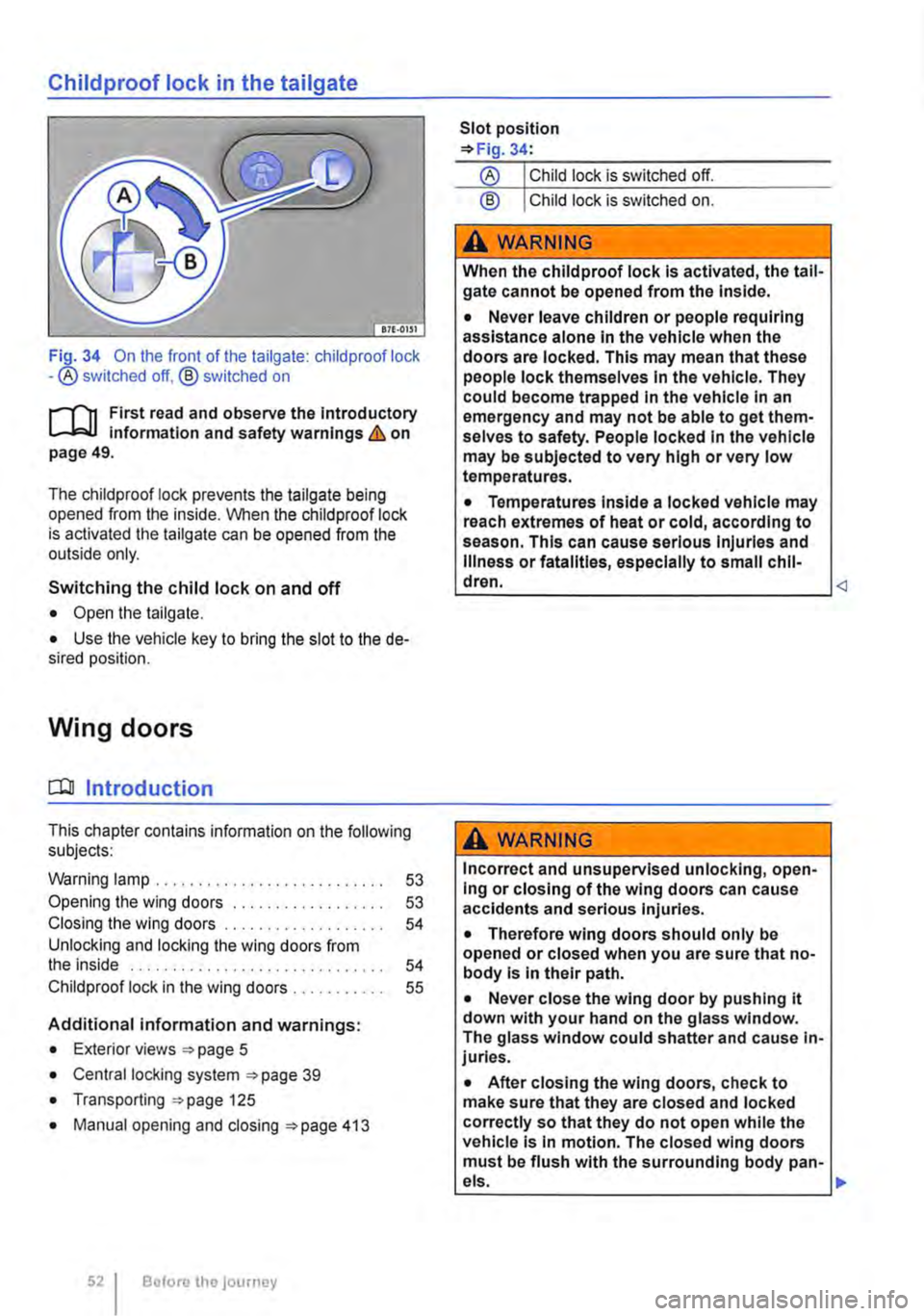
Childproof lock in the tailgate
Fi_Q-34 On the front of the tailgate: child proof lock -®switched off, @ switched on
rJ'n First read and observe the introductory l-J.:.U information and safety warnings & on page 49.
The childproof lock prevents the tailgate being opened from the inside. When the child proof lock is activated the tailgate can be opened from the outside only.
Switching the child lock on and off
• Open the tailgate.
• Use the vehicle key to bring the slot to the de-sired position.
Wing doors
CQJ Introduction
This chapter contains information on the following subjects:
Warning lamp . . . . . . . . . . 53
Opening the wing doors 53 Closing the wing doors 54 Unlocking and locking the wing doors from the inside . . . . . . . . . . . . . . . . . . . . . . . . . . . . . . 54 Child proof lock in the wing doors . 55
Additional information and warnings:
• Exterior views =>page 5
• Central locking system =>page 39
• Transporting =>page 125
• Manual opening and closing =>page 413
52 Before the journey
Slot position =>Fig. 34:
@ Child lock is switched on.
A WARNING
When the childproof lock Is activated, the tail-gate cannot be opened from the Inside.
• Never leave children or people requiring assistance alone In the vehicle when the doors are locked. This may mean that these people lock themselves In the vehicle. They could become trapped In the vehicle In an emergency and may not be able to get them-selves to safety. People locked In the vehicle may be subjected to very high or very low temperatures.
• Temperatures Inside a locked vehicle may reach extremes of heat or cold, according to season. This can cause serious Injuries and Illness or fatalities, especially to small chil-dren.
Incorrect and unsupervised unlocking, open-Ing or closing of the wing doors can cause accidents and serious Injuries.
• Therefore wing doors should only be opened or closed when you are sure that no-body Is In their path.
• Never close the wing door by pushing it down with your hand on the glass window. The glass window could shatter and cause in-juries.
• After closing the wing doors, check to make sure that they are closed and locked correctly so that they do not open while the vehicle Is In motion. The closed wing doors must be flush with the surrounding body pan-
•
Page 55 of 486
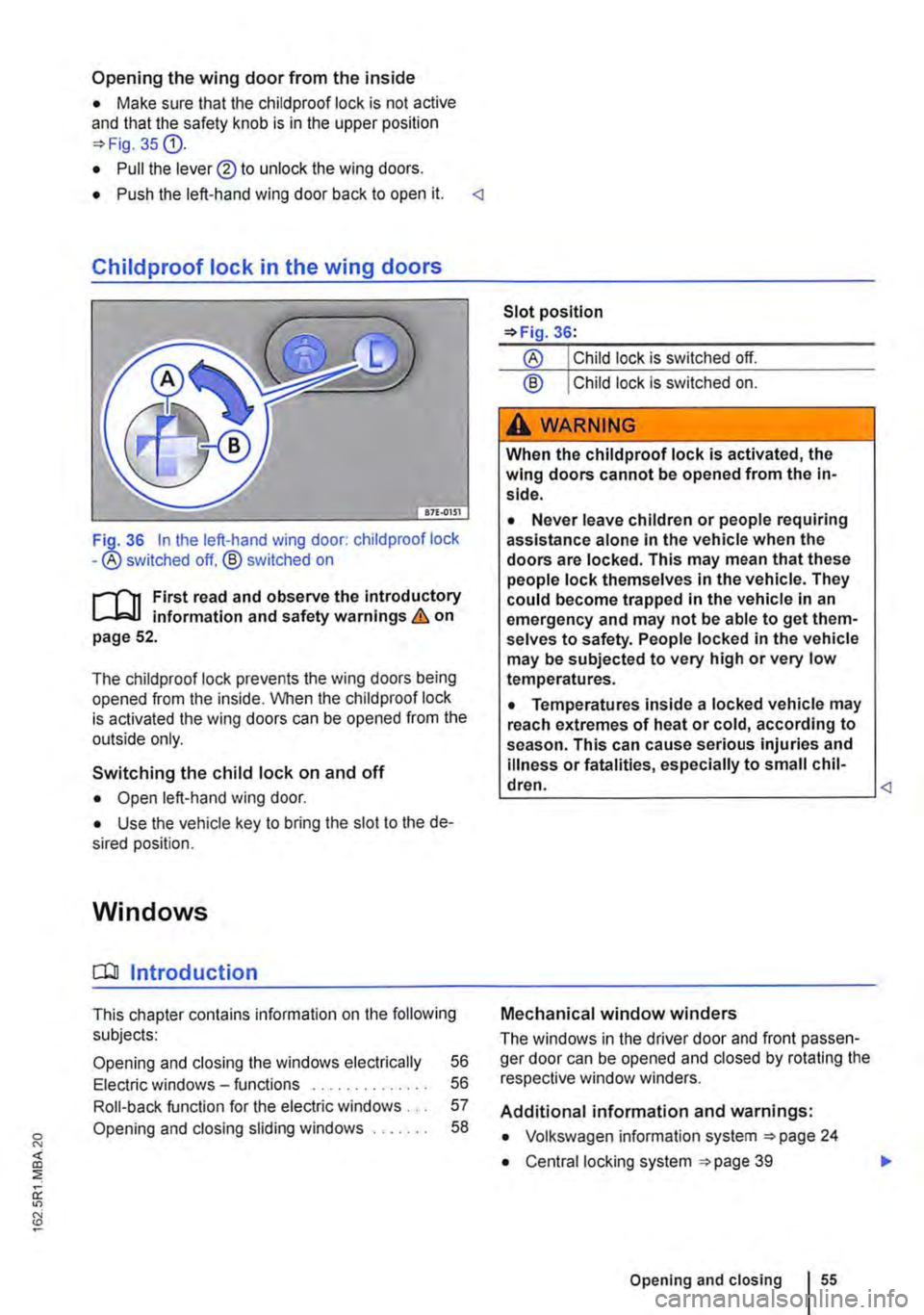
Opening the wing door from the inside
• Make sure that the child proof lock is not active and that the safety knob is in the upper position 35{!).
• Pull the lever® to unlock the wing doors.
• Push the left-hand wing door back to open it. <1
Childproof lock in the wing doors
36 In the left-hand wing door: child proof lock -® switched off. ® switched on
,......,.., First read and observe the introductory information and safety warnings & on page 52.
The chiidproof lock prevents the wing doors being opened from the inside. When the child proof lock is activated the wing doors can be opened from the outside only.
Switching the child lock on and off
• Open left-hand wing door.
• Use the vehicle key to bring the slot to the de-sired position.
Windows
a:n Introduction
This chapter contains information on the following subjects:
Opening and closing the windows electrically 56
Electric windows -functions . . . . . . . . . . . . . . 56
Roll-back function for the electric windows . . . 57
Opening and closing sliding windows . . . . . . . 58
® Child lock is switched on.
A WARNING
When the child proof lock is activated, the wing doors cannot be opened from the in-side.
• Never leave children or people requiring assistance alone in the vehicle when the doors are locked. This may mean that these people lock themselves in the vehicle. They could become trapped in the vehicle in an emergency and may not be able to get them-selves to safety. People locked in the vehicle may be subjected to very high or very low temperatures.
• Temperatures inside a locked vehicle may reach extremes of heat or cold, according to season. This can cause serious injuries and illness or fatalities, especially to small chil-dren. <1
Mechanical window winders
The windows in the driver door and front passen-ger door can be opened and closed by rotating the respective window winders.
Additional information and warnings:
• Volkswagen information system 24
• Central locking system 39
Opening and closing I 55
..
Page 57 of 486
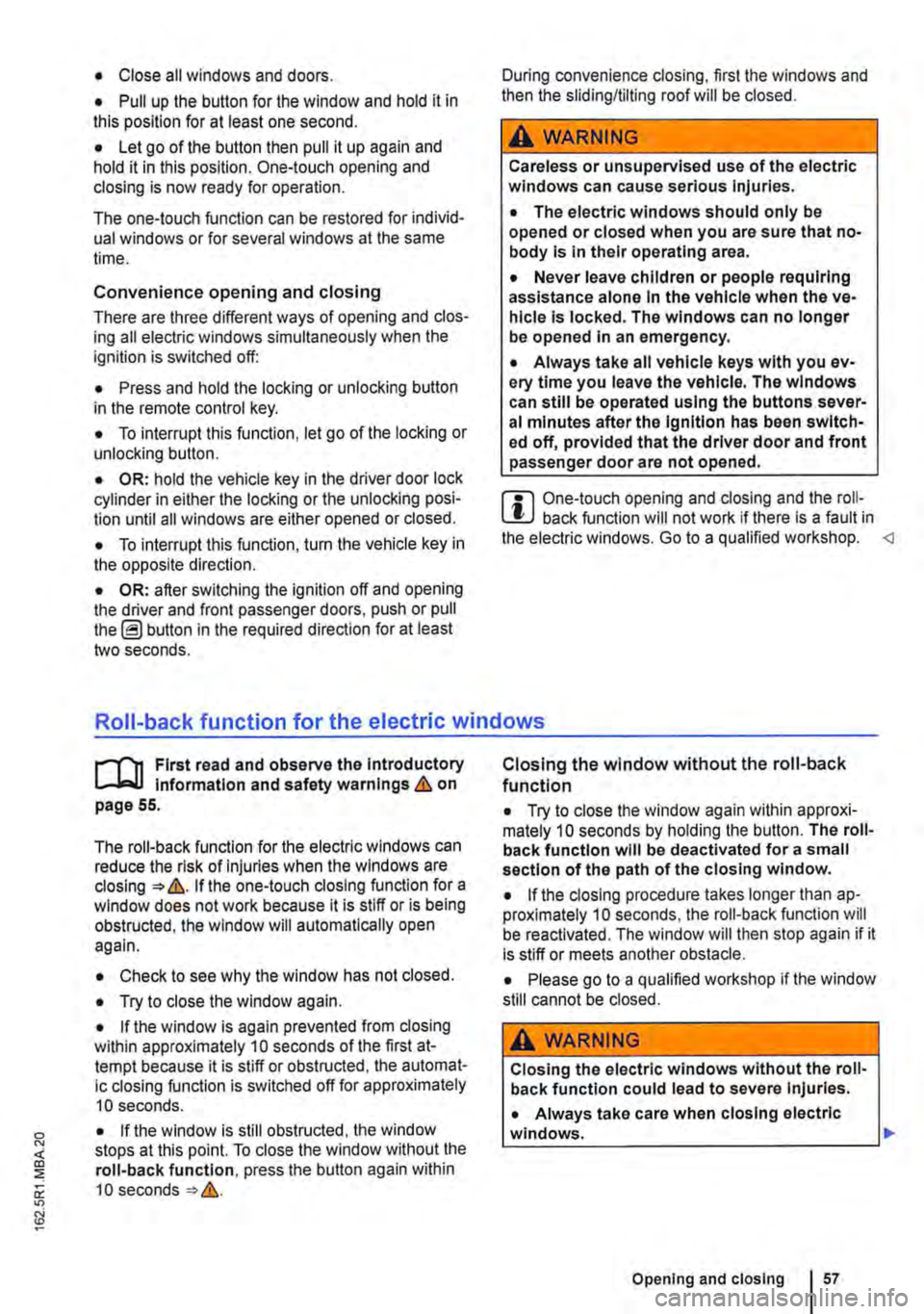
• Close all windows and doors.
• Pull up the button for the window and hold it in this position for at least one second.
• Let go of the button then pull it up again and hold it in this position. One-touch opening and closing is now ready for operation.
The one-touch function can be restored for individ-ual windows or for several windows at the same time.
Convenience opening and closing
There are three different ways of opening and clos-ing all electric windows simultaneously when the ignition is switched off:
• Press and hold the locking or unlocking button in the remote control key.
• To interrupt this function, let go of the locking or unlocking button.
• OR: hold the vehicle key in the driver door lock cylinder in either the locking or the unlocking posi-tion until all windows are either opened or closed.
• To interrupt this function, turn the vehicle key in the opposite direction.
• OR: after switching the ignition off and opening the driver and front passenger doors, push or pull the@ button in the required direction for at least two seconds.
During convenience closing, first the windows and then the sliding/tilting roof will be closed.
A WARNING
Careless or unsupervised use of the electric windows can cause serious Injuries.
• The electric windows should only be opened or closed when you are sure that no-body is in their operating area.
• Never leave children or people requiring assistance alone In the vehicle when the ve-hicle is locked. The windows can no longer be opened In an emergency.
• Always take all vehicle keys with you ev-ery time you leave the vehicle. The windows can still be operated using the buttons sever-al minutes after the Ignition has been switch-ed off, provided that the driver door and front passenger door are not opened.
m One-touch opening and closing and the roii-L!J back function will not work if there is a fault in the electric windows. Go to a qualified workshop.
l"""l'l1 First read and observe the Introductory l-J,a,IJ Information and safety warnings & on page 55.
The roll-back function for the electric windows can reduce the risk of Injuries when the windows are closing :) &. If the one-touch closing function for a window does not work because it is stiff or is being obstructed, the window will automatically open again.
• Check to see why the window has not closed.
• Try to close the window again.
• If the window is again prevented from closing within approximately 10 seconds of the first at-tempt because it is stiff or obstructed, the automat-ic closing function is switched off for approximately 10 seconds.
• If the window is still obstructed, the window stops at this point. To close the window without the roll-back function, press the button again within 1 0 seconds :) &.
Closing the window without the roll-back function
• Try to close the window again within approxi-mately 10 seconds by holding the button. The roll-back function will be deactivated for a small section of the path of the closing window.
• If the closing procedure takes longer than ap-proximately 10 seconds, the roll-back function will be reactivated. The window will then stop again if it is stiff or meets another obstacle.
• Please go to a qualified workshop if the window still cannot be closed.
A WARNING
Closing the electric windows without the roll-back function could lead to severe Injuries.
• Always take care when closing electric windows. 11>
Opening and closing
Page 58 of 486
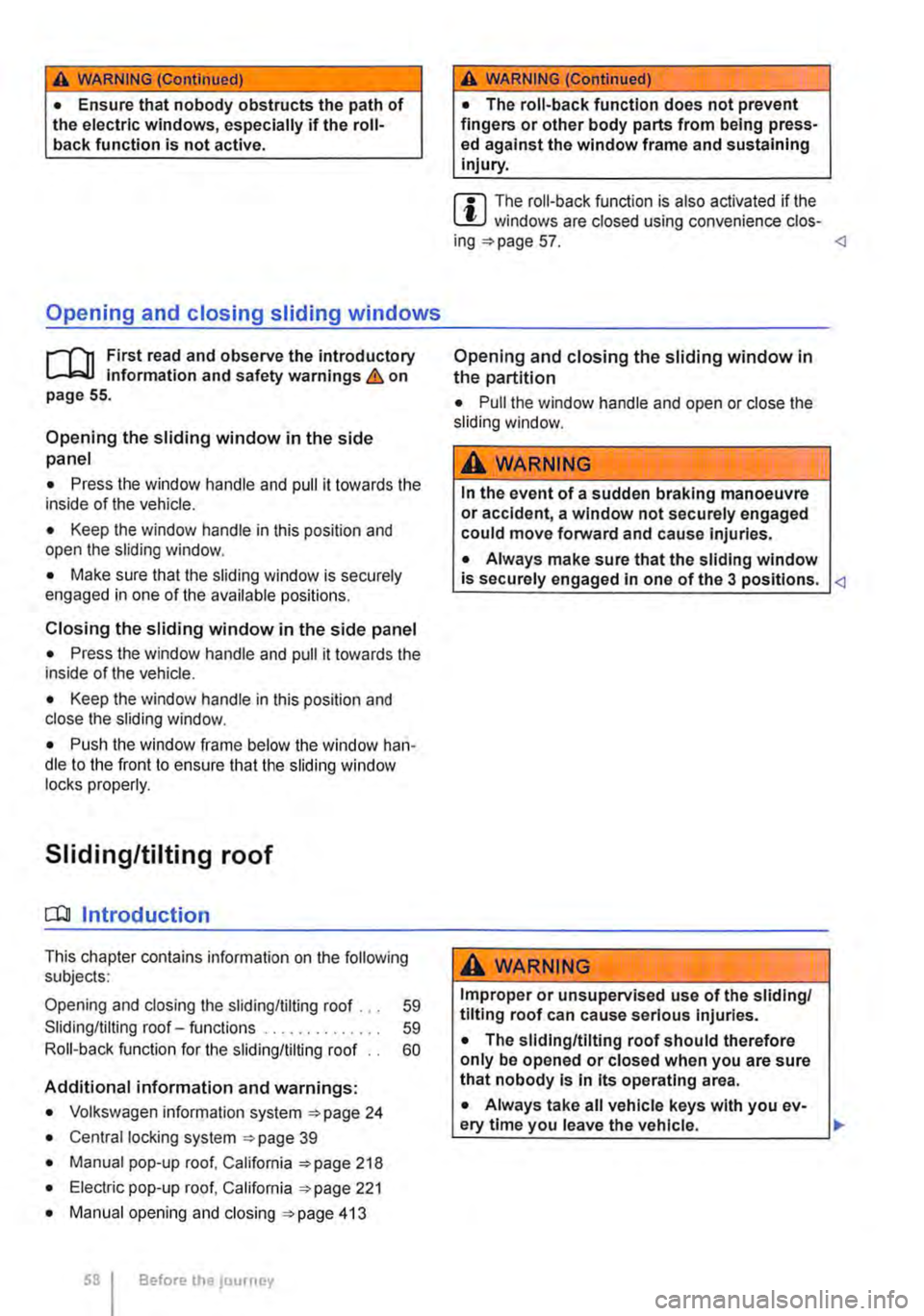
A WARNING (Continued)
• Ensure that nobody obstructs the path of the electric windows, especially if the roll-back function is not active.
Opening and closing sliding windows
r-T'n First read and observe the introductory L-.lr::.U information and safety warnings & on page 55.
Opening the sliding window in the side panel
• Press the window handle and pull it towards the inside of the vehicle.
• Keep the window handle in this position and open the sliding window.
• Make sure that the sliding window is securely engaged in one of the available positions.
Closing the sliding window in the side panel
• Press the window handle and pull it towards the inside of the vehicle.
• Keep the window handle in this position and close the sliding window.
• Push the window frame below the window han-dle to the front to ensure that the sliding window locks properly.
Sliding/tilting roof
0::0 Introduction
This chapter contains information on the following subjects:
Opening and closing the sliding/tilting roof . . . 59
Sliding/tilting roof-functions . . . . . . . . . . . . 59 Roil-back function for the sliding/tilting roof 60
Additional information and warnings:
• Volkswagen information system 24
• Central locking system 39
• Manual pop-up roof, California 218
• Electric pop-up roof, California 221
• Manual opening and closing 413
58 Before the journey
A WARNING (Continued)
• The roll-back function does not prevent fingers or other body parts from being press-ed against the window frame and sustaining injury.
m The roll-back function is also activated if the W windows are closed using convenience clos-ing 57.
• Pull the window handle and open or close the sliding window.
A WARNING
In the event of a sudden braking manoeuvre or accident, a window not securely engaged could move forward and cause injuries.
• Always make sure that the sliding window is securely engaged in one of the 3 positions.
Improper or unsupervised use of the sliding/ tilting roof can cause serious Injuries.
• The sliding/tilting roof should therefore only be opened or closed when you are sure that nobody is In its operating area.
• Always take all vehicle keys with you ev-ery time you leave the vehicle. 11>